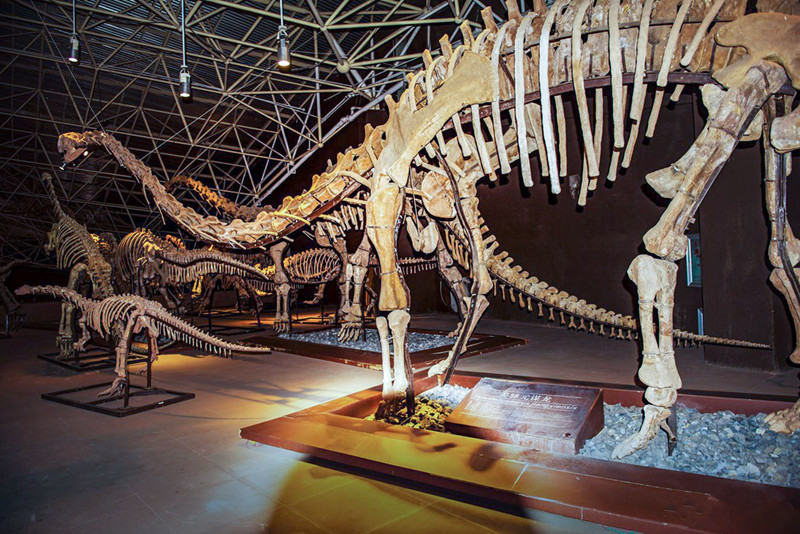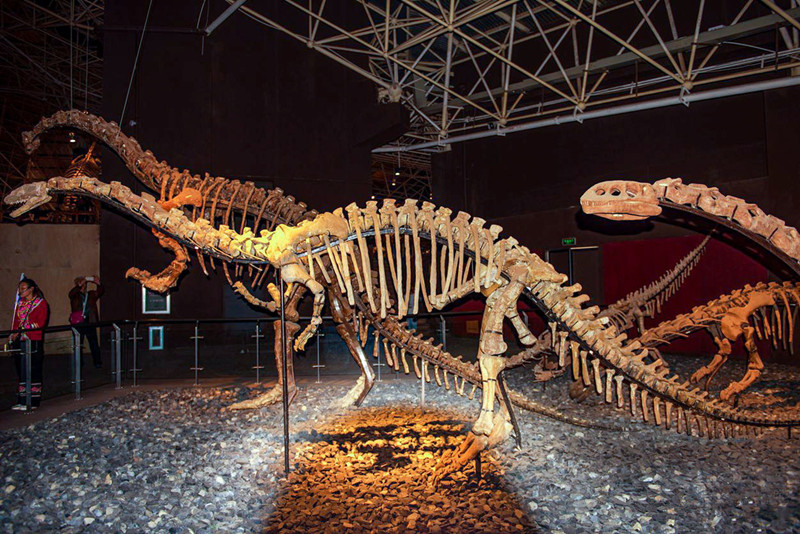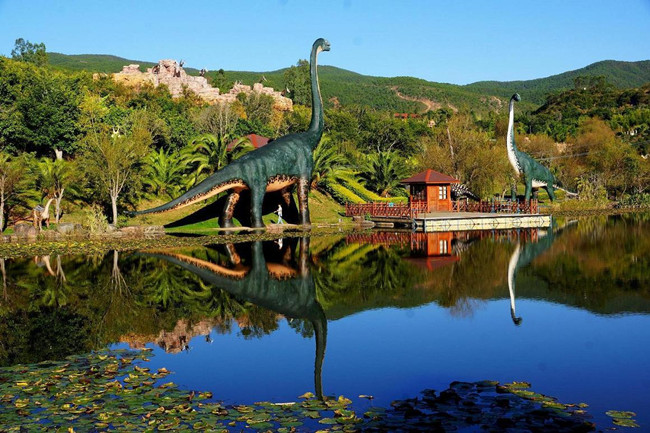
Lufengosaurus in Yunnan
Lufengosaurus (Chinese: 祿豐龍 or 禄丰龙, meaning “Lufeng Lizard”) was a prosauropod dinosaur that lived during the Early and Middle Jurassic period in what is now southwestern China. Known for being the first complete dinosaur skeleton mounted in China, Lufengosaurus was also commemorated on a postage stamp in 1958.
1. Discovery and Species
Discovery
- In the late 1930s, geologist Bien Meinian began uncovering fossils at Shawan near Lufeng in Yunnan province.
- In 1938, paleontologist Yang Zhongjian (C.C. Young in the West) joined the excavation.
- In 1941, Yang named the remains of a prosauropod Lufengosaurus huenei, with the generic name referring to Lufeng and the specific name honoring his tutor, Friedrich von Huene.
Holotype
- The holotype, IVPP V15, is a partial skeleton found in the Lower Lufeng Formation, which dates to the Lower Jurassic (Hettangian–Sinemurian).
Second Species
- Yang named a second species, Lufengosaurus magnus, in 1940/1941 and fully described it in 1947. This species was significantly larger than L. huenei but is often considered a junior synonym of L. huenei.
Significance
- An exemplar of Lufengosaurus was the first complete dinosaur skeleton mounted in China in 1958, celebrated with an 8-yuan postage stamp.
Other Prosauropods
- Yang named another prosauropod, Gyposaurus sinensis, in 1940. This species was considered identical to Lufengosaurus by Peter Galton in 1976 but is generally doubted today.
Further Classification
- Michael Cooper suggested in 1981 that Lufengosaurus and Yunnanosaurus were species of the South African genus Massospondylus. However, a reanalysis in 2005 established Lufengosaurus as a distinct genus.
Undescribed Species
- In 1985, Zhao Xijin named another species, Lufengosaurus changduensis, based on a specimen found in Tibet, which remains an undescribed nomen nudum.
Lufeng World Dinosaur Valley Park, Chuxiong
2. Description
Size
- Lufengosaurus is often described as a small prosauropod, about 6 meters (20 ft) long. Including “L. magnus” specimens, it could reach 9 meters (30 ft) in length and weigh 1.7 metric tons (1.9 short tons).
Physical Traits
- It had a long neck, short forelimbs, and was inferred to be bipedal. The full osteology was published by Yang in 1941.
Lufeng World Dinosaur Valley Park, Chuxiong
Skull
Features
- The skull was deep and broad, with distinctive bony bumps behind its large nostrils and on its cheeks.
- A bony ridge on the side of the upper jaw might have anchored soft tissue, suggesting larger cheeks compared to other sauropodomorphs.
- It had closely spaced, serrated teeth suited for a diet of leaves.
Key Points about Lufengosaurus
Discovery:
- Lufengosaurus was discovered in the Lufeng Basin, a renowned fossil site in Yunnan Province.
- The genus was first described in 1941 by Chinese paleontologist Yang Zhongjian (also known as C.C. Young).
Classification:
- Lufengosaurus belongs to the order Saurischia, suborder Sauropodomorpha.
- It is classified within the family Massospondylidae, a group of early sauropodomorph dinosaurs.
Physical Characteristics:
- Lufengosaurus was a relatively small to medium-sized dinosaur, measuring about 6 to 9 meters (20 to 30 feet) in length.
- It had a long neck and tail, a small head, and a bipedal stance, though it could likely walk on all fours as well.
- The dinosaur had strong hind limbs and shorter forelimbs with grasping hands, suggesting it may have been able to manipulate objects or food.
Diet and Behavior:
- Lufengosaurus was primarily herbivorous, feeding on plants.
- Its teeth were adapted for a plant-based diet, and its long neck allowed it to reach vegetation at various heights.
Significance:
- The discovery of Lufengosaurus has provided significant insights into the early evolution of sauropodomorph dinosaurs.
- It is one of the best-preserved early sauropodomorphs and has contributed to our understanding of the transition from small, bipedal ancestors to the giant, quadrupedal sauropods of later periods.
Lufeng Basin Fossil Site
The Lufeng Basin in Yunnan Province is one of the most important fossil sites in China, known for its rich deposits of early Jurassic dinosaur fossils.
Geological Formation:
- The Lufeng Formation, where Lufengosaurus was discovered, dates to the Early Jurassic period, approximately 190 to 200 million years ago.
- The sedimentary rocks in this formation have preserved a wide variety of fossils, including those of dinosaurs, amphibians, reptiles, and early mammals.
Other Significant Finds:
- In addition to Lufengosaurus, the Lufeng Basin has yielded fossils of other dinosaur genera, such as Yunnanosaurus and Sinosaurus.
- The basin has also provided important fossils of early mammals, offering insights into the evolution of mammals during the Mesozoic era.
Paleontological Research:
- The Lufeng Basin has been the focus of extensive paleontological research, with numerous expeditions and studies conducted by Chinese and international scientists.
- Fossils from this region have contributed to a better understanding of early dinosaur evolution and the biodiversity of the Jurassic period.
Visiting the Lufeng Basin
For those interested in paleontology and natural history, the Lufeng Basin and its associated museums offer a fascinating glimpse into the ancient past. The Yunnan Provincial Museum in Kunming, for example, displays many fossils from the Lufeng Basin, including specimens of Lufengosaurus, providing an educational experience about the region’s rich paleontological heritage.
























